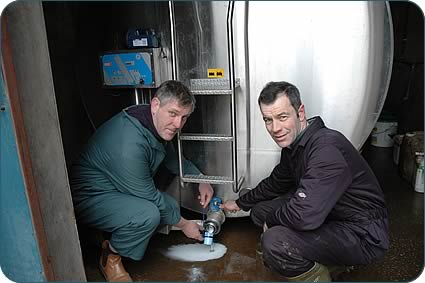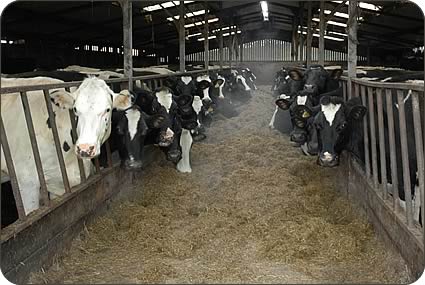Jennifer MacKenzie is an agricultural photo journalist with almost 30 year's experience. Operating from her base in Cumbria, Jennifer undertakes mainly industry-related freelance writing and photography.
Proactive approach to Johnes disease
Dairy farmer Ian Bulman has taken a proactive approach to disease control since an outbreak of BVD in his herd 10 years ago, carrying out an animal health testing and vaccination programme at Bank House, Armathwaite, near Carlisle in consultation with his vet.
 |
| Vet Graham Brooks takes a milk sample to test for Johne's Disease in Ian Bulman's Bankhouse Holstein herd. |
Johne's disease is caused by a slow-growing organism, Mycobacterium avium subspecies paratuberculosis, often known as MAP, that may not be detected for many years making it important for farmers to be vigilant for signs of the disease. These include reduced milk output or reduced fertility in older animals, profuse diarrhoea and significant weight loss in advanced stages of the disease.
Guidance to the dairy industry on the control of Johne's Disease in dairy herds was published by Defra 18 months ago (Sept 04), in partnership with the British Cattle Veterinary Association (BCVA).
The guidance suggested that farmers should prepare a herd health and welfare plan with their vet which should include measures to control the disease such as early removal of diseased cattle, not breeding from offspring, and making sure that calves only receive colostrum from their own mother where possible.
Last September (2005) at the Dairy Event the Johne's Initiative was launched with backing which included the National Beef Association, National Farmers Union, Livestock Auctioneers Association, Royal Association of British Dairy Farmers, Holstein UK, Cattle Health Certification Standards, British Cattle Veterinary Association, Scottish Agricultural College and Defra.
The aim of the Johne's Initiative is to raise awareness of the disease and encourage farmers to test and cull and identify other measures which can be taken on farm to reduce risk of infection. Improved bio-security and hygiene, particularly in calf rearing units, is seen as a major objective. Rabbits and other wildlife have been shown to contract the disease and control of rabbits on pasture will help break the cycle.
Accreditation for freedom from Johne's Disease is available to qualifying herds through cattle health schemes approved by Cattle Health Certification Standards (CHeCS).
 |
| Coomara vet Graham Brooks and Ian Bulman with the Bankhouse Herd. |
In addition to the economic benefits to individual farmers, the eradication of the disease is vitally important in pedigree herds, to prevent transmission into commercial herds, and will be an important factor in developing exports of British pedigree stock when export markets re-open. Johne's Disease can halve the productive life of a bull.
The total cost to the dairy industry of Johne's Disease is difficult to estimate as the disease can seriously impair the performance of cattle long before clinical signs appear. The long incubation period means clinical signs of the disease may not appear until the animal is three to six years of age, although it will harbour the disease sub-clinically before then.
Mr Brooks said: “Most dairy farmers will have heard of Johne’s disease and are probably aware that the main symptom is a cow losing weight with profuse diarrhoea, and a majority will probably remember having a cow with these symptoms at some point in their farming career.
“What most farmers will not realise is that the cows that scour are only the tip of the iceberg. A lot of cows are slaughtered out of the national dairy herd each year for weight loss, poor milk production and poor fertility. A significant proportion of these cows are infected with Johne’s disease and the symptoms are due to this infection.
“Johne’s disease is an insidious disease, with calves being infected soon after birth either from infected colostrums or faecal contamination on the cow’s teats or in the environment. It does not pass from cow to cow.
“This infection then takes a long time usually two to three years before it begins to have an effect upon the animal’s health. These cows will be shedding bacteria in their faecaes before they show any symptoms; this means that the next generation of animals is infected without the farmer knowing it.”
The results are reduced productivity, fertility problems, weight loss and large economic problems if it becomes advanced within the herd. With possible links to the human Crohn’s disease, as yet to be established, there are also implications for sales of milk and stock.
 |
Johne’s disease was more prevalent in re-stocked herds and certain breeds were more susceptible (eg Channel Island). In Cumbria 60 herds had Johne’s however bulk tank tests carried out by Coomara had so far proved negative.
Mr Brooks said that main difficulty in the past with the diagnosis of Johne’s disease was that each individual animal had to be looked at in turn to make a diagnosis. Tests are both expensive and also very insensitive. The gold standard test is faecal culturing but this can take up to six weeks for a positive diagnosis.
He said that examining a faeces sample from scoured cows under the microscope will usually give a positive diagnosis but the animals in sub-clinical disease may appear negative.
Animals can also develop antibodies to the bacteria, but this is usually late in the infection. Therefore in the past blood screening tests have had to be carried out on a large number of animals to determine if any animals in the herd are infected.
This needs to be repeated at regular intervals to detect those animals that are incubating the disease; this has made the process expensive and in general has only been taken up in herds which are selling high genetic animals or where there is known to be a problem.
“The recent development of a bulk milk antibody test for Johne’s disease means that we now have a cheap and easily performed test that can be repeated on a regular basis to assess the Johne’s disease status of the dairy herd,” said Mr Brooks.
“Most farmers will be familiar with monitoring of disease by using bulk milk antibody tests which tests for Leptospirosis, Bovine Viral Diarrhoea (BVD) and Infectious Bovine Rhinotracheitis (IBR) being available for a number of years now. The Johne’s disease test is the same only requires the collection of a well-agitated bulk milk sample.”
The bulk tank test costs £7 although pharmaceutical company Virbac, which is importing the vaccine for Johne’s, is currently offering the test free, with back-up vaccination should a test prove positive.
“Due to the possibility that young cows in the herd may be infected but not yet producing antibodies it is not possible to say that a herd is free from the disease, but as more tests are carried out, with negative results, then the probability increases.
“The test also gives a result of positive suggesting that there are a number of cows in the herd infected and producing antibodies. Depending on the herd, there are a number of ways to determine which cows are infected.
“Bulk milk samples can be taken from various subsets of cows i.e. first lactation heifers, second calvers, older cows etc. This will allow the extent of the infection in the herd to be determined. Individual cows can be blood tested to determine their status.
“The main advantage of the bulk milk test is it allows the disease status of the herd to be known and this allows specific herd health planning to be instigated to control the disease in the herd or to prevent it’s introduction into a free herd.”

